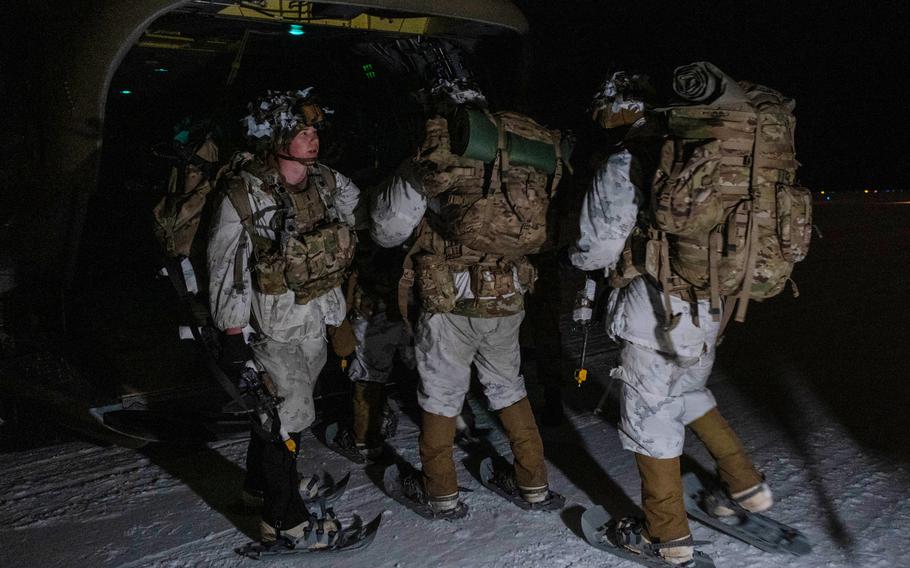
U.S. Army soldiers assigned to Bounty Hunter Troop, 5th Squadron, 1st Cavalry Regiment, 1st Infantry Brigade Combat Team, 11th Airborne Division, load onto a CH-47 Chinook to depart for an Air Assault during Operation Wolf Valkyrie, Fort Wainwright, Alaska, Nov. 30, 2023. (Aaron Downing/U.S. Army)
During the darkest and coldest days in Alaska, when the sun peeks from the horizon for less than five hours and ice-rimmed thermometers dive to readings of -25, some of the 7,000 soldiers at the Army’s northernmost base in the world line up for a bone-rattling dunk into “The Hole.”
Tethered to a safety team, the volunteers representing their company stand over a water-filled pit in full combat camouflage gear. They step off, splash, bob to the surface, orient themselves and reverse, then they have 30 seconds to climb out under their own power.
“Chest on the ice, pull yourself out,” a sergeant can be heard yelling to a soldier splashing at the lip of the ice in a Fort Wainwright-produced video.
For the soldiers of Fort Wainwright near Fairbanks, it’s an embrace of the extreme world where they live, train and could conceivably fight.
Col. Steve Phillips, former commander of the 1st Infantry Brigade, has done “The Hole” and said it serves a real purpose beyond getting shivering and soaked.
“When you are looking down at that dark water, it takes a degree of personal courage to take the step off,” said Phillips, now a division deputy commander. “You are doing it for yourself and your team.”
The Hole symbolizes fortitude, endurance and confidence that troops can operate in and even dominate an extreme environment, he said.
The bitter cold central Alaska winter will play host Thursday to 10,000 American and Canadian troops participating in the Joint Pacific Multinational Readiness Center-Alaska 24-02 exercises. The war games will test the ability of the units to meld into a combined force that could take on adversaries such as Russia and China who are increasingly active in the polar regions.
“Alaska will kill you,” Phillips said. “People here say that with pride. There is a fundamental difference in what it takes to survive here than in other places soldiers serve.”
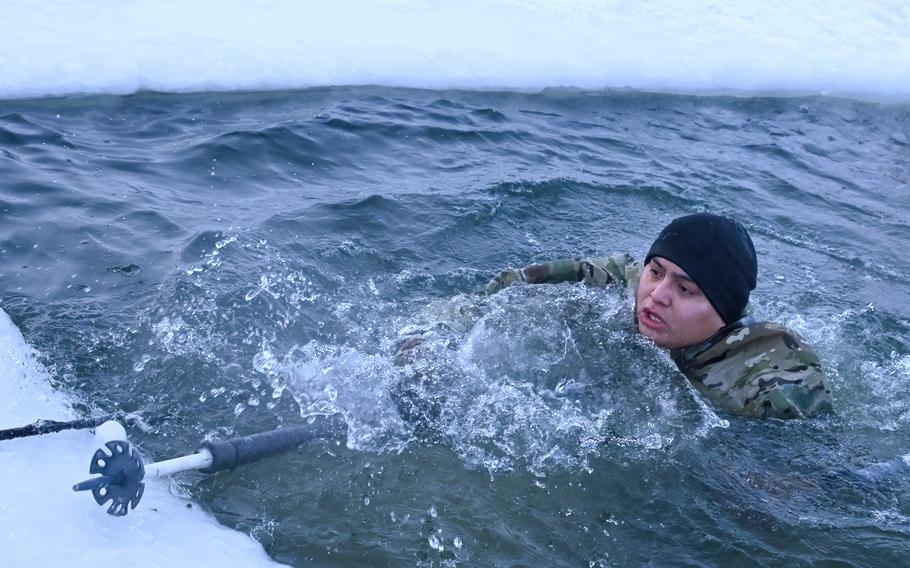
A soldier from Fort Wainwright, Alaska, in December 2023 works his way out of “The Hole,” an icy water hole that’s part of a competition among soldiers of the 1st Brigade of the 11th Airborne Division. (U.S. Army)
A world of extremes
The Hole is primarily a competition for the 1st Brigade of the 11th Airborne Division, the air-assault infantry nicknamed the “Arctic Wolves.”
The Arctic Wolves company with the most successful exits from The Hole gets the honor of carrying the brigade guidon pole topped with a wrought gun-metal head of a growling wolf.
The 11th Airborne Division also includes the parachute-qualified 2nd Infantry Brigade, nicknamed “The Spartans,” which operates from Joint Base Elmendorf-Richardson near Anchorage.
The 11th Airborne Division, with the two brigade combat teams, and aviation, support, training and reconnaissance units, are the “Arctic Angels.”
While the 1st Brigade is the infantry fighting force, the lesson is front and center for every soldier at Fort Wainwright. A uniform check is not a by-the-book formality. At Fort Wainwright, it ensures soldiers don’t freeze their fingers, toes and nose.
The wilderness has grizzly bears, lynxes, wolverines and wolf packs. Finding yourself between a 1,200-pound Moose and her young is unlikely to end well.
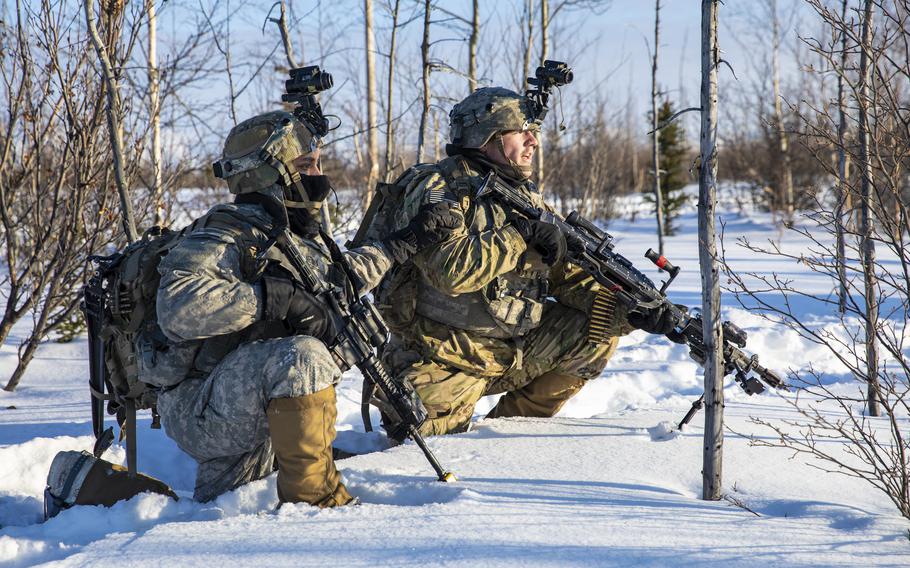
Soldiers of the 1st Brigade, 11th Airborne based at Fort Wainwright in Alaska on a training patrol. (U.S. Army)
Fort Wainwright’s soldiers operate in an unforgiving environment, where helicopters flying too low and close in a mountain gap or assault vehicles driving a treacherous icy dirt road to a training ground have led to fatal accidents in the past year. The Army has worked to improve mental health services for soldiers and their families who are far from home and can face mental and emotional struggles when there is so little light for so long.
The challenge of serving in central Alaska is made plain before soldiers ship out to Fort Wainwright. They qualify for a bonus of up to $4,000 that serves as a reward and a warning. The “remote and austere conditions assignment incentive pay” is meant to be spent on personal clothes, gear and deep-freeze, winter equipment, such as engine block heaters for the family car.
Single soldiers at Fort Wainwright receive $2,000, and those bringing dependents receive $4,000. Soldiers serving at Elmendorf-Richardson in the relatively urbanized Anchorage area receive half the amount.
Top of the world
Phillips said Fort Wainwright’s soldiers are stationed so far north because of a strategic need. That can seem odd, even to soldiers arriving for duty at the remote garrison.
“It makes people scratch their heads,” he said. “I’m in Alaska, and this does not compute with the Pacific command being at Fort Shafter, Hawaii.”
Phillips had a simple trick to get people to understand.
He would grab a globe and turn it on its side with the polar region pointed at his audience.
(Noga Ami-rav/Stars and Stripes)
“When you start to view the globe, not with the equator in the center in North and South America in prominence, but focus the North Pole at the center, you start to realize, ‘holy cow,’ this makes sense,” Phillips said.
Russia’s closest point is 53 miles from Alaska across the Bering Strait. NATO has an increasing number of regional members including Canada, Norway, and Danish-controlled Greenland now being joined by Finland and Sweden.
China also has declared itself an “arctic adjacent” nation and has held joint naval exercises with Russia in the polar region. With global warming, shipping channels across the top of North America and Europe are becoming a new area of military and commercial competition.
If ground combat were to occur in the Arctic, Fort Wainwright would be the place to learn needed tactics that units trained in warmer climates won’t know.
A river in July can force a unit to pivot in another direction in Alaska. The same river in February can be frozen solid and serve as a highway carrying troops faster to their objective.
Phillips said risk is always a factor. The goal is to master the environment when possible, and knowing when to forge ahead can be dicey.
“We need to dominate this environment in times to come if we get into a conflict,” he said.
A healthier, more lethal soldier
Col. Mike Arnett leads the Fort Wainwright medical team as deputy commander of clinical services.
He said dealing with hypothermia and frostbite and transporting ill or injured patients to trauma-oriented hospitals in Anchorage are all part of the challenge for the doctors, nurses and other staff at Fort Wainwright. An overriding issue is getting soldiers to take care of themselves and others physically and mentally.
While depression from darkness and cold can prey on soldiers and their families, having a sense of being part of a crucial mission can outweigh any seasonal affective disorder that can spread throughout the homes and offices at the base.
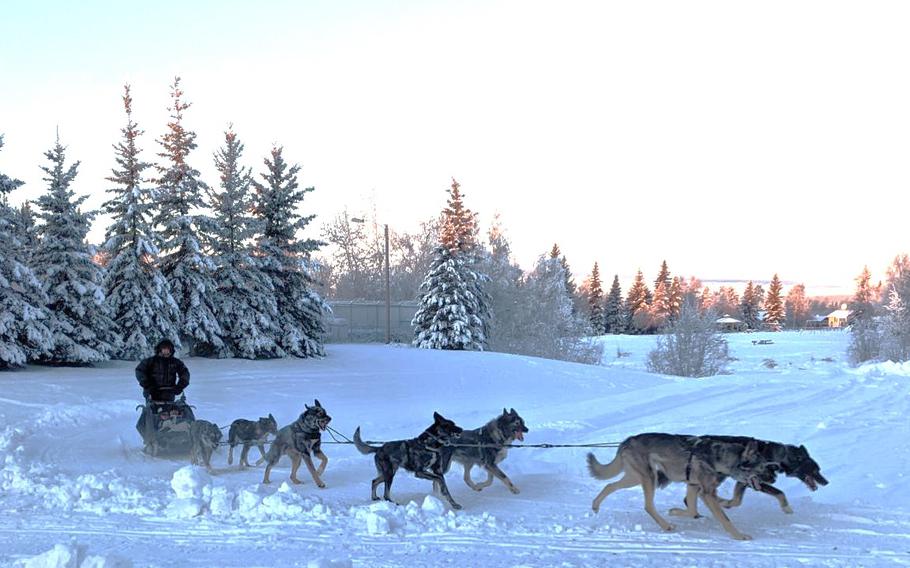
Col. Mike Arnett, the top medical officer at Fort Wainwright, goes out for some dog mushing near Fairbanks, Alaska. (U.S. Army)
“The more that is done to give them a sense of purpose, a tribe they belong to — that will help their health, including behavioral health. From what I can see, the 11th Division is applying more resources, giving people more activities,” Arnett said.
The investment in time, money and attitude to make Fort Wainwright feel more bearable, welcoming and enjoyable make it seem like their home.
Resiliency builds strength, Arnett said, including on the battlefield.
“It also makes them more lethal in this environment,” he said.
It’s humbling
Cpl. Sarah Myers transferred from Fort Riley, Kan., to Fort Wainwright in December 2021, right into the shock of the sub-zero winter.
The nearly sunless days and deep-freeze temperatures were unlike any winter back home in Yadkinville, a North Carolina town of roughly 3,000 residents about 30 minutes west of Winston-Salem.
“The first winter was rough,” she said. “I remember losing feeling in my fingertips.”
Serving with a general support aviation battalion at Fort Wainwright, she has worked year-round on and in UH-60 Black Hawks, CH-47 Chinooks and UH-60 Medevac Support helicopters.
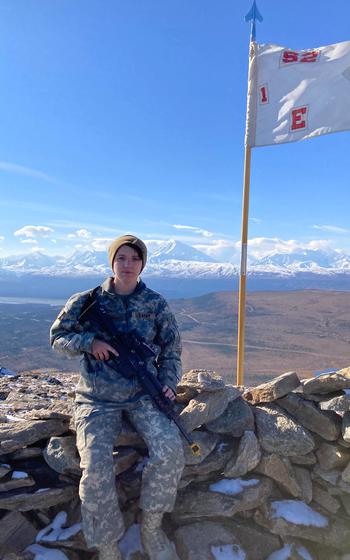
Army Cpl. Sarah Myers serving at Fort Wainwright, Alaska, the northernmost U.S. military installation in the world. The North Carolina native has learned to live with — and even enjoy at times — the extremes of dark, cold winters and summers with barely any night. (U.S. Army)
Two years later, Myers still isn’t ready to say that serving at the Army’s base closest to the North Pole is something she wants to make permanent.
“I don’t like the 24-hour dark or the 24-hour day in June,” she said. “In winter, I crochet, play guitar, sing and keep close to the people in my company. We get it — it’s hard here. We stay hydrated, and we stay connected with people back home.”
Myers endures the winters, explores the summers in her 2012 Jeep Grand Cherokee and is happy that Alaska is a stop in her life.
“It’s a place that’s humbled me as a person,” she said. “It makes me know I am stronger than I think. I can handle more situations. It’s another thing off my to-do list in ‘adulting.’”
Myers can now wear the experience on her sleeve.
“I now have my Arctic tab,” she said.